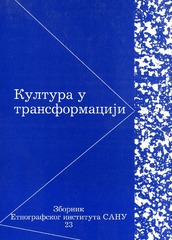Приказ основних података о документу
Ко кога наслеђује? – врањски крај у другој половини двадесетог века
Who Inherits Whom in the 2nd Half of the 20th Century in the Vranje Area?
| dc.creator | Ђорђевић, Јадранка | |
| dc.date.accessioned | 2020-05-27T15:51:55Z | |
| dc.date.available | 2020-05-27T15:51:55Z | |
| dc.date.issued | 2007 | |
| dc.identifier.isbn | 978-86-7587-042-5 | |
| dc.identifier.uri | https://dais.sanu.ac.rs/123456789/8755 | |
| dc.identifier.uri | https://dais.sanu.ac.rs/123456789/8758 | |
| dc.description.abstract | У раду се говори о регулисању наследних односа у врањском крају, у социјалистичком и постсоцијалистичком времену. Истраживање је конципирано тако да се паралелно посматрају и анализирају обичајно право и државноправни систем. Однос између обичајног права и легислатуре посматран је на нивоу праксе и то са намером да се установе и објасне не само разлози већ и последице њихове упоредне примене приликом наслеђивања материјалних покретних и непокретних добара. | sr |
| dc.description.abstract | This paper covers regulations and practice in inheritance matters in the area of Vranje during the socialist and post-socialist period. The research covered and analyzed customary law and the state regulative on inheritance. It is concluded that the inheritance matters in the area are based on the customary law: females do not inherit property if they have male siblings. They are entitled to dowry instead, mostly mobile material goods, which also refers to all the property that a female might inherit from her parents. In fact, the interviewed females stated that would give up their own share of a property in favor of the male siblings, emphasizing hence personal relationships over material goods. These females are the carriers of the customary law, which they support in spite the fact that they remain oppressed in terms of inheritance. The customary law, present in Serbia in these terms for centuries, is based on the principle of patrilineality and patrilocality, which is in contrast with the official regulative. The paper further discusses ideal and real life situations related to inheritance, ideal and preferred models and behaviors, the relationship of the customary and official regulative… | en |
| dc.language.iso | sr | sr |
| dc.publisher | Београд : Етнографски институт САНУ / Belgrade : Institute of Ethnography SASA | sr |
| dc.relation | Projekat 2157: Tradicionalna kultura Srba – sistemi predstava, obreda i socijalnih institucija, Ministarstvo za nauku, tehnologiju i razvoj Republike Srbije | sr |
| dc.relation | info:eu-repo/grantAgreement/MESTD/MPN2006-2010/147020/RS// | sr |
| dc.rights | openAccess | sr |
| dc.rights.uri | https://creativecommons.org/licenses/by-nc-sa/4.0/ | |
| dc.source | Култура у трансформацији / Culture in Transformation | sr |
| dc.subject | наследни односи | sr |
| dc.subject | обичајно право | sr |
| dc.subject | легислатура | sr |
| dc.subject | Врање са околином | sr |
| dc.subject | inheritance | sr |
| dc.subject | regulations | sr |
| dc.subject | customary law | sr |
| dc.subject | legislative | sr |
| dc.subject | Vranje and the surrounding area | sr |
| dc.title | Ко кога наслеђује? – врањски крај у другој половини двадесетог века | sr |
| dc.title | Who Inherits Whom in the 2nd Half of the 20th Century in the Vranje Area? | en |
| dc.type | bookPart | sr |
| dc.rights.license | BY-NC-SA | sr |
| dcterms.abstract | Đorđević, Jadranka; Ko koga nasleđuje? – vranjski kraj u drugoj polovini dvadesetog veka; | |
| dc.rights.holder | Етнографски институт САНУ | sr |
| dc.citation.spage | 47 | |
| dc.citation.epage | 61 | |
| dc.description.other | Зборник радова Етнографског института САНУ 23 / Collection of Papers of the Institute of Ethnography SASA 23 | sr |
| dc.type.version | publishedVersion | sr |
| dc.identifier.fulltext | https://dais.sanu.ac.rs/bitstream/id/33393/bitstream_33393.pdf | |
| dc.identifier.rcub | https://hdl.handle.net/21.15107/rcub_dais_8758 |

